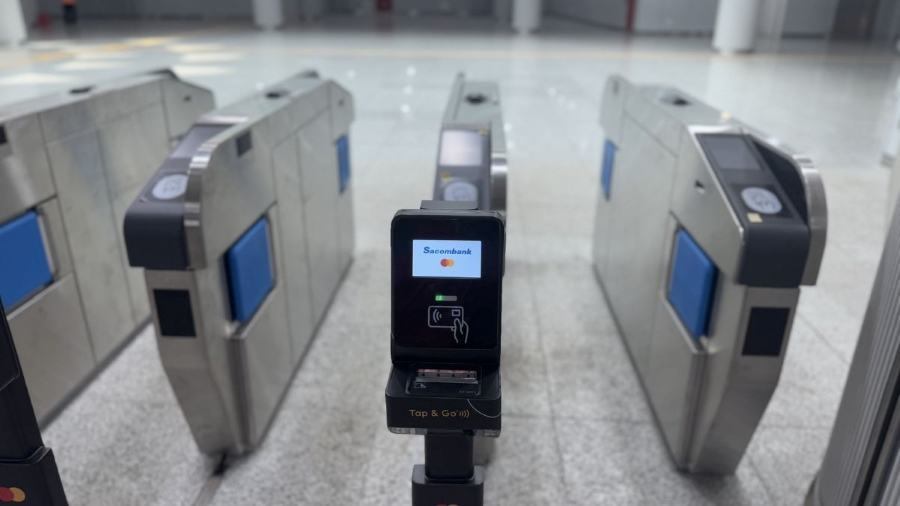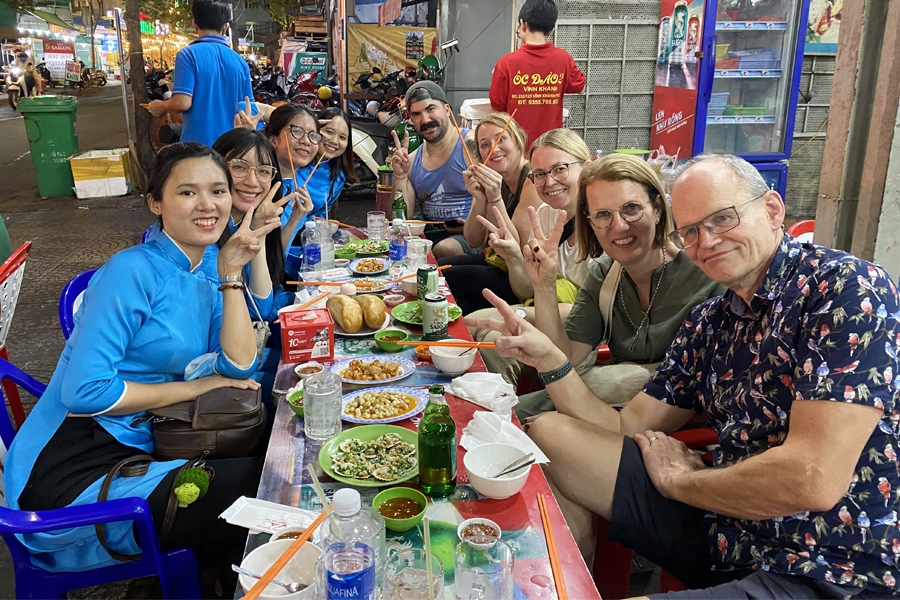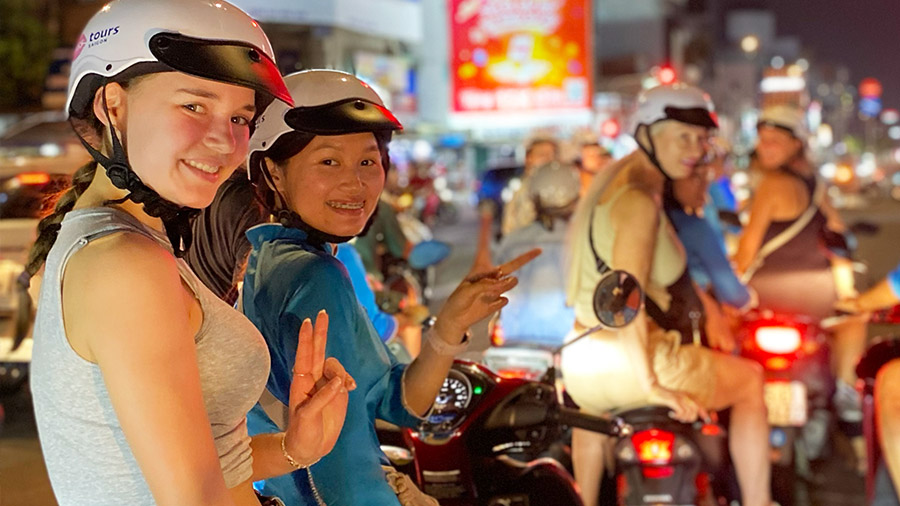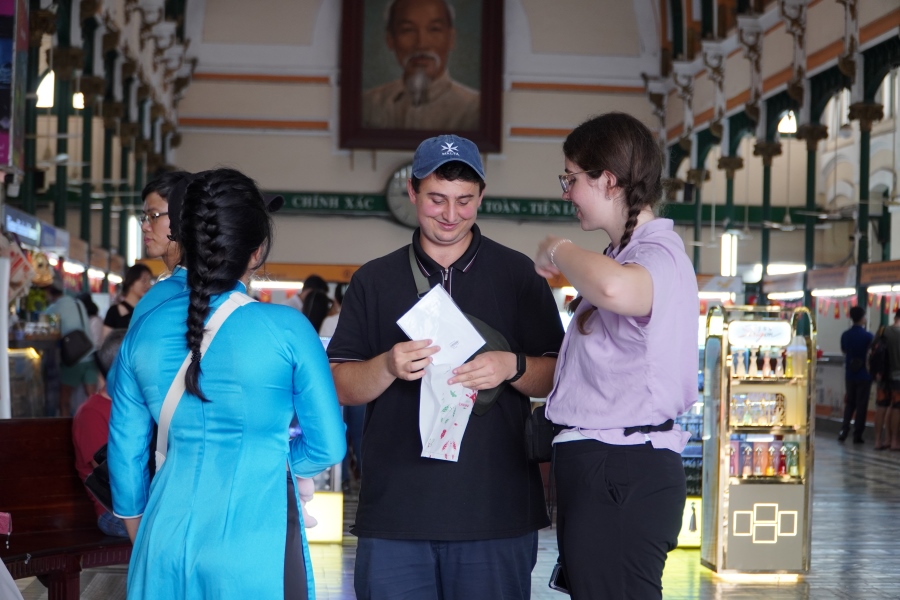Vietnam now offers e-visas for all nationalities (up to 90 days, single or multiple entry). Some travelers enjoy visa exemptions from 14-90 days, and Phu Quoc Island grants 30 days visa-free. Visa on Arrival is still available at major airports with an approval letter.
Are you embarking on a journey through Vietnam’s captivating landscapes? The first step is demystifying the process of obtaining a visa. In this guide, we’ll unravel the intricacies, requirements, and essential tips, ensuring your quest for a Vietnam e-visa is as smooth as the forthcoming adventure. Join us as we navigate the path together, answering the question on every traveler’s mind: How do I get a Vietnam e-visa and Vietnam Visa On Arrival? Get ready to unlock the doors to the wonders that await you in this country.
1. Vietnam Visa Exemptions 2025
1.1 List of Visa-Exempt Countries
Vietnam extends visa exemptions to citizens of 29 countries holding valid ordinary passports, providing a hassle-free entry experience. The duration of these exemptions varies, ranging from 14 to 90 days, with specific conditions for each category. Here’s a breakdown:
- Maximum stay of 14 days: Brunei, Myanmar
- Maximum stay of 21 days: Philippines
- Maximum stay of 30 days: Cambodia, Indonesia, Kyrgyzstan, Laos, Malaysia, Singapore, Thailand
- Maximum stay of 45 days: Germany, France, Italy, Spain, the U.K., Northern Ireland, Russia, Japan, South Korea, Denmark, Sweden, Norway, Finland, Belarus
- Maximum stay of 90 days: Chile, Panama
From 15 March 2025 to 14 March 2028, citizens of 12 European countries (Germany, France, Italy, Spain, UK, Russia, Japan, South Korea, Denmark, Sweden, Norway, Finland) enjoy a 45-day visa exemption under Resolution No. 44/NQ-CP.
As part of the tourism stimulus program, Poland, Czech Republic, and Switzerland also benefit from a 45-day visa exemption in 2025, but only when traveling with an official Vietnam tour operator (Form 2 required).
The 30-day re-entry rule has been abolished, meaning travelers can now re-enter Vietnam freely within their exemption period without waiting.
Note: Passports must be valid for at least 6 months from your entry date, and you may be asked to show a return or onward ticket.
1.2 Key Conditions for Visa Exemption
- To qualify for visa exemption, your passports must have a validity of at least 6 months from the arrival date.
- Travelers from different countries can enjoy their stay in Vietnam within the specified durations, provided they present round-trip tickets or tickets for a third country upon arrival at customs.
- For passport holders from Russia, Japan, South Korea, Denmark, Norway, Finland, Sweden, Belarus, the UK, France, Germany, Spain, and Italy who enter Vietnam with unilateral visa exemption, the entry date must be separated by at least 30 days from the previous exit under unilateral visa exemption.
- Failure to comply with this 30-day gap requirement necessitates obtaining an appropriate visa to enter Vietnam. In other words, a minimum of 30 days must pass between two visa-exempt travels.
1.3 Special Case: Visa-Free Travel to Phu Quoc
Phu Quoc is the only place in Vietnam where you can visit for up to 30 days without a visa, but only if you stay on the island the whole time. Foreign passport holders enjoy visa exemption for both entry into and exit from Phu Quoc Island.
If you’re planning to visit the mainland or other parts of Vietnam, a visa becomes a requisite, especially if you’re coming from countries like Cambodia, Thailand, or Laos. This usually happens if you’re traveling by land instead of flying in. Without a visa, border guards won’t let you enter the country.
1.4 Vietnam Visa for U.S. Citizens
The exclusive visa option available for US passport holders visiting Vietnam is the one-year multiple-entry visa. This implies that individuals from the United States can no longer obtain visas with durations of 01 month, 03 months, or 06 months. The prescribed visa requires US citizens to exit Vietnam every three months throughout the one-year validity period.
It’s worth noting that for US citizens, the associated costs are relatively high, encompassing a stamping fee of $135 and a service fee for the agent to secure an approval letter, typically starting from $35 or higher.
2. Vietnam E-visa

Starting August 15, 2023, citizens from all countries and territories can now enjoy the convenience of Vietnam e-visa, offering a 90-day stay and permitting multiple entries.
2.1. Processing Time
The official processing time for Vietnam e-visa applications is approximately 03 working days. However, this timeframe can fluctuate depending on factors like current application volume and upcoming holidays. To avoid any delays and guarantee receipt before your arrival in Vietnam, we recommend submitting your application 1-2 weeks in advance.
2.2. Application Fee
The fee for applying for an e-visa to enter Vietnam is 25 USD/single entry visa. This fee is non-refundable if your application is refused or your visa contains incorrect information that you provided in the application form.
>>> Check out this video for more information about Vietnam visa!
2.3. How to Apply for Vietnam e-visa Online
Step 1: Prepare Your Application Materials
Before applying for your e-visa, gather the following:
- Valid passport: Your passport must have at least 6 months of validity remaining from your planned departure date from Vietnam.
- Passport photo: One recent 4×6 passport photo in .jpg format, with a white background and no glasses.
- Passport data page scan: A scan of your passport data page in .jpg format.
- Vietnam travel details: Provide your temporary residence address in Vietnam, preferred port of entry, and planned port of exit.
- Payment method: A debit or credit card for online payment
Step 2: Submit the Online Application
- Visit the official Vietnam e-visa website: https://evisa.xuatnhapcanh.gov.vn/en_US/web/guest/khai-thi-thuc-dien-tu/cap-thi-thuc-dien-tu
- Fill out the secure online form with your prepared information.
Step 3: Pay the Vietnam e-visa fee upon confirmation and Download your visa
Once you’ve completed the e-visa application form, payment is required. The fees are $25 for a single entry and $50 for multiple entries. Remember, this is separate from the stamping fee, which must be paid in cash (Vietnamese dong or US dollars) upon arrival at your designated entry port. To avoid delays, ensure you have the exact amount ready before your departure.
Don’t forget to copy the registration code provided. This code will allow you to print your official Vietnam e-visa document.
Step 4: Present your E-visa or verification code at the border
Upon arriving at the Vietnamese border, be prepared to present either your printed e-visa or the verification code you received previously.
Tip: The e-visa now allows multiple entries, which is especially useful for travelers combining Vietnam with nearby destinations like Cambodia, Laos, or Thailand.
2.4. List Countries that Can Use the Vietnam e-visa
The E-Visa program in Vietnam is open to citizens hailing from the countries provided below:
- Andorra
- Argentina
- Armenia
- Azerbaijan
- Bulgaria
- Belarus
- Belgium
- Bosnia and Herzegovina
- Brazil
- Brunei
- Canada
- Chile
- China (Only for passports with the letter G at the beginning; Not for Macau, Hong Kong, Taiwan, or China mainland with an E letter in the passport number)
- Colombia
- Croatia
- Cuba
- Cyprus
- Czech Republic
- Germany
- Denmark
- Finland
- France
- Greece
- Hungary
- Ireland
- Italy
- Japan
- Kazakhstan
- Korea (South)
- Luxembourg
- Myanmar
- Mongolia
- Norway
- Panama
- Peru
- Philippines
- Poland
- Romania
- Russia
- Slovakia
- Spain
- Sweden
- Timor Leste
- Uruguay
- The United Kingdom of Great Britain and Northern Ireland
- United States of America
- Venezuela
- Australia
- UAE
- Canada
- India
- The Netherlands
- New Zealand
- Norway
- Palau
- Panama
- Papua New Guinea
- Peru
- Philippines
- Poland
- Portugal
- Qatar
- Romania
- Russia
- Samoa
- San Marino
- Serbia
- Slovakia
- Slovenia
- Solomon Islands
- Spain
- Sweden
- Switzerland
- Timor – Leste
- UAE
- United Kingdom
- United States of America
- Uruguay
- Vanuatu
- Venezuela
List of Border Gates Authorized for Foreign Entry using E-visas in Vietnam
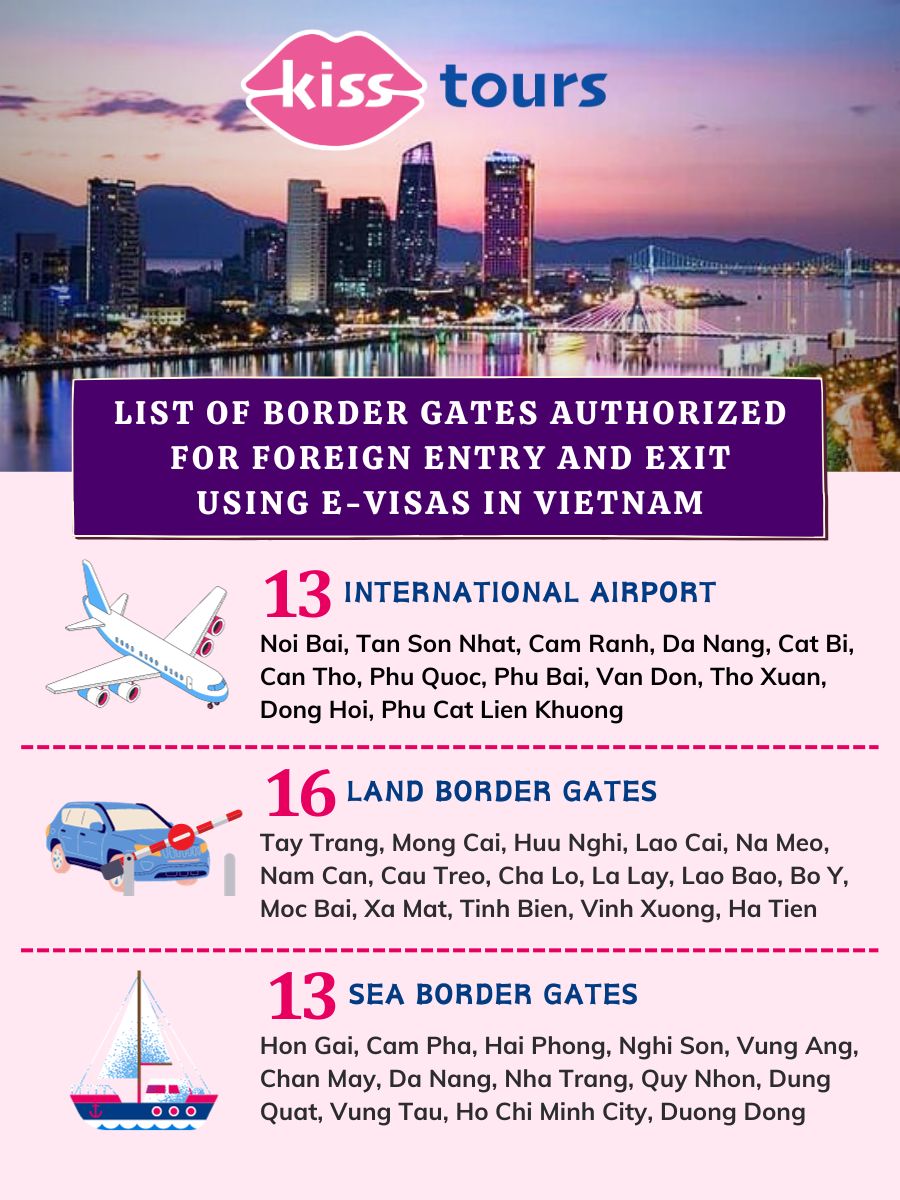
International Airports:
- Can Tho International Airport (VCA) – Can Tho City
- Dong Hoi International Airport (VDH) – Quang Binh Province
- Lien Khuong International Airport (DLI ) – Lam Dong Province
- Da Nang International Airport (DAD) – Da Nang City
- Cat Bi International Airport (HPH ) – Hai Phong Province
- Noi Bai International Airport (HAN) – Hanoi City
- Tan Son Nhat International Airport (SGN ) – Ho Chi Minh City
- Phu Bai International Airport (HUI) – Hue City
- Cam Ranh International Airport (CXR) – Khanh Hoa Province
- Phu Quoc International Airport (PQC) – Kien Giang Province
- Phu Cat International Airport (UIH) – Binh Dinh Province
- Tho Xuan International Airport (THD) – Thanh Hoa Province
Landports:
- Bo Y Landport
- Cha Lo Landport
- Cau Treo Landport
- Huu Nghi Landport
- Ha Tien Landport
- Lao Bao Landport
- Lao Cai Landport
- La Lay Landport
- Moc Bai Landport
- Mong Cai Landport
- Nam Can Landport
- Na Meo Landport
- Song Tien Landport
- Tinh Bien Landport
- Tay Trang Landport
- Xa Mat Landport
Seaports:
- Chan May Seaport (Thua Thien – Hue Province)
- Da Nang Seaport (Da Nang City)
- Quy Nhon Seaport (Binh Dinh Province)
- Ho Chi Minh Seaport (Ho Chi Minh City)
- Vung Tau Seaport (Ba Ria Province)
- Cam Pha Seaport (Quang Ninh Province)
- Hon Gai Seaport (Quang Ninh Province)
- Nghi Son Seaport (Thanh Hoa Province)
- Hai Phong Seaport (Hai Phong City)
- Dung Quat Seaport (Quang Ngai Province)
- Duong Dong Seaport (Phu Quoc – Kien Giang Province)
- Vung Ang Seaport (Ha Tinh Province)
- Nha Trang (Khanh Hoa Province)
3. Vietnam Visa on Arrival – VOA
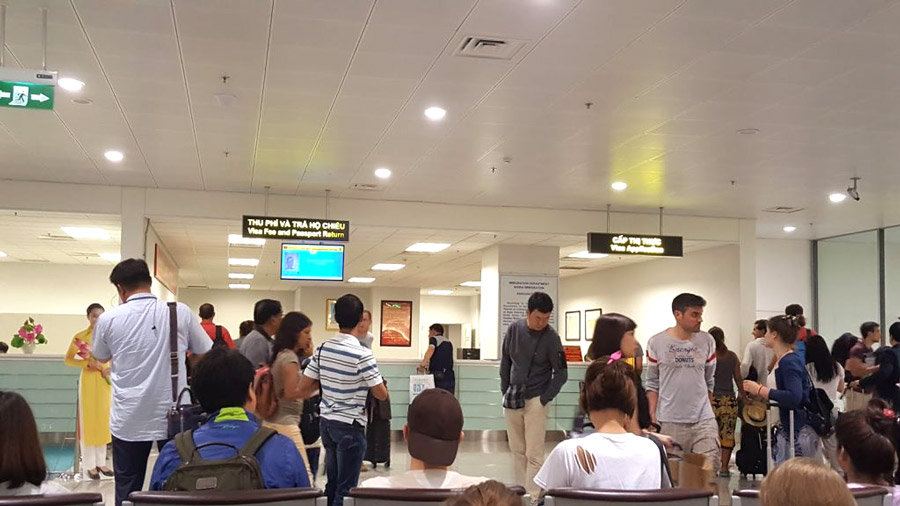
Vietnam Visa on Arrival (VOA) can be obtained upon arrival at the country’s international airports. An agent can assist you in securing the visa approval letter beforehand. Tailored for air travel, this visa option is only applicable for those entering Vietnam by plane.
3.1. How to Get a Visa on Arrival in Vietnam
Upon arrival at one of Vietnam’s international airports (Hanoi, Da Nang, or Ho Chi Minh City), you can obtain your visa stamp directly at the Immigration counter. To do so, present the following documents:
- Visa approval letter (printed)
- Valid passport with at least 6 months of remaining validity
- Two recent passport-sized photos (taken within the last 6 months)
Once your documents are verified and the fees are paid (cash only), you’ll receive your passport with the stamped visa, allowing you to enter Vietnam.
3.2. Advantages of Visa on Arrival
No need for postal services
Eliminates the risk and waiting time associated with sending your passport to the Vietnamese embassy for visa processing. This is particularly beneficial for stays exceeding 30 days or multiple entries.
3.3. Disadvantages of Visa on Arrival
Limited entry points
Applicable only for entry through the designated airports; entry via land borders or seaports requires a pre-arranged visa.
Airport restriction
Visa stamping can only be done at one of the three specified airports.
Waiting times
Expect wait times at the Immigration counter ranging from 30 minutes to 2.5 hours, depending on passenger volume.
4. Notes & Travel Tips for Vietnam Visa Applicants
4.1. Vietnam E-visa
- Double-check your personal information! Errors in your E-visa application will lead to lost fees with no refund.
- Enter the address of your first Vietnamese accommodation in the “Residential Address in Vietnam” field.
- Note: The port of entry listed on your E-visa cannot be changed. If you need to alter this information, you must apply for a new E-visa.
- Processing times vary; expect your E-visa within 3 working days on average. However, delays are possible during peak periods or holidays. To ensure timely arrival, submit your application at least 2 weeks before your trip.
- Group applications are not allowed. Each E-visa application must be for one individual only.
4.2. Vietnam Visa On Arrival – VOA
- Important: VOA is not a visa itself, but rather a pre-arranged approval letter exchanged for a visa stamp upon arrival.
- When choosing between visa options, consider your travel plans and select the best fit.
- Make sure your passport has at least 6 months of validity remaining beyond your planned departure from Vietnam.
>>> Here are all you need to know and some travel tips for smooth immigration. Save this video for your Vietnam trip!
To help you have a more fulfilling and safe trip to Vietnam, here are some tips that you might find useful!
- What are the common and convenient payment methods for you when you come to Vietnam?
- Is Vietnam Safe? Uncovering the Enjoyable Side of Travel in Vietnam!
- Ensuring Safe Travels: A Guide to Avoiding Scams in Vietnam 2024.
- Top Ho Chi Minh City street food that you must try!
AND!
If you want to immerse yourself in the cultural identity and make friends with locals when you come to Vietnam, consider taking a guided tour and street food experience with a local guide.
You can take the Saigon By Night and Street Food Tour of Kiss Tour. These tours allow you to explore the vibrant and lively city of Ho Chi Minh City on motorbikes after the sun sets. Alternatively, the Saigon City Tour is also a great option if you want to explore the city during the day.
With your friendly and knowledgeable guides, they will take you to the most iconic places and provide insights into Vietnamese food and culture. This feels like you’re hanging out with friends and you just need to enjoy the trip!


